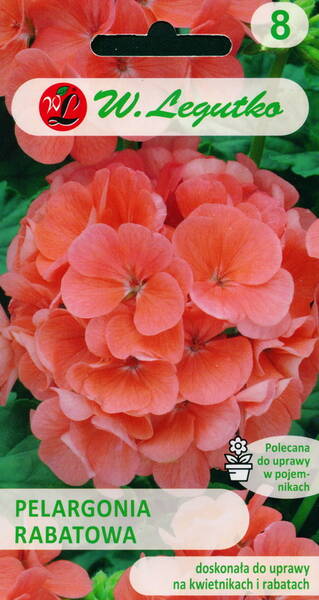The new pelargonium hybrid blooms 2 weeks earlier than any other!
Plants have a compact, well-branched habit. The height of the plants is 25-30 cm, which are covered with a large number of bright salmon-pink flowers all season.
Early and abundant flowering from spring to the first frost will provide a magnificent view of the flower garden and garden.
Agricultural technology.
Perennial grown in the garden as an annual. Sowing seedlings in light soil to a depth of 1 cm. At an optimum temperature of +20°C, they germinate in 5-10 days.
Pick after 3 weeks in pots with a diameter of 3 cm. Do not allow the soil to dry out and temperature fluctuations.
The recommended temperature for growth is +15°C. There are about 200 seeds in 1,0 g.
GROWING CONDITIONS.
By their nature, pelargoniums are very undemanding.
They are thermophilic, but modern varieties and, especially, F1 hybrids are more resistant to adverse weather conditions and endure even short-term weak frosts by autumn.
They can grow well both in bright sun and in partial shade, which makes it possible to decorate them with both sunny and moderately shaded areas.
Soils for pelargoniums should be selected loose, nutritious, moderately moist and well permeable, because. plant roots do not tolerate soaking.
REPRODUCTION BY SEEDS.
Seeds are sown very early, in December - January, because. flowering begins 5-6 months after sowing.
The soil is loose and light, based on peat or with the addition of sand (or perlite).
Seeds are sown in grooves or scattered on the surface of the soil and lightly sprinkled with earth.
Crops are covered with a film or glass and periodically sprinkled with water to maintain constant humidity.
The optimum temperature for seed germination is +21...+22°C. Seedlings appear 7-8 days after sowing.
Immediately after this, the seedlings should be provided with good lighting. With a lack of light, the plants will stretch strongly and may die.
During the development of seedlings and seedlings, the temperature should be slightly reduced to + 18 ° C.
Watering during this period needs moderate (so that the soil does not dry out, but is not too damp).
When 1-2 true leaves appear, the plants dive one by one in 8 cm pots, and when they reach a height of 8-10 cm, they pinch the top of the shoot.
LANDING IN THE GROUND.
Seedlings of zonal pelargonium are planted in the ground in late May - early June, when the threat of return frosts has passed.
In flower beds - at a distance of 20-25 cm, in containers and boxes - 15 cm apart.
The soil is better to use loamy, structural, not blocking, with a pH of 6.2-6.5.
Peaty or sandy soils are not suitable for growing pelargoniums.
* During the development of seedlings, it is desirable to provide daylight hours lasting 14-18 hours. The lengthening of daylight hours contributes to the earlier flowering of pelargoniums.
Feeding seedlings begin 5-7 days after picking. In the future, they are carried out once every 7 days. They use complex mineral fertilizers (nitrophoska, fertik, etc. - 30-35 g / 10 l of water), mullein tincture or, with a lack of nitrogen (if the leaves turn pale green and the plants slow down growth) - nitrogen fertilizers (urea, ammonium nitrate and etc.). Good results are obtained by alternating mineral fertilizers with organic and biofertilizers based on humic acids (Humate, huumus, etc.).
* If pelargoniums were sown early, and the plants grew strongly by spring, they can be transferred to larger pots with a diameter of 10 cm before planting in the ground or before sale.
Eng.: Horseshoe pelargonium.













